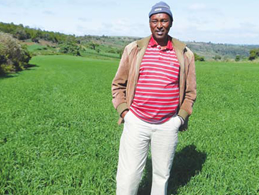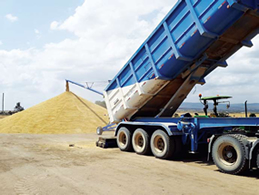Barley Farming Evolutionary Survivor
 The government should offer support in terms of financing, machinery, subsidize fertilizer and seeds for barley farmers. These will encourage farmers to do it as a business where they are assured of return on investment, provide employment to youths and improve our exports which in turn improves our foreign exchange. Mr. Thomas Kipkorir, the Country Manager. Crop Protection and Public Health Business at BASF has worked with barley farmers for long. In a conversation with Cereals Magazine, he shared his experience.
The government should offer support in terms of financing, machinery, subsidize fertilizer and seeds for barley farmers. These will encourage farmers to do it as a business where they are assured of return on investment, provide employment to youths and improve our exports which in turn improves our foreign exchange. Mr. Thomas Kipkorir, the Country Manager. Crop Protection and Public Health Business at BASF has worked with barley farmers for long. In a conversation with Cereals Magazine, he shared his experience.
Discuss barley farming globally and Kenya.
Barley is a member of the grass family and is a major cereal grain. Important uses of Barley include animal fodder, source of fermentable material for beer and certain distilled beverages, and as a component of various health foods.
The grains are commonly made into malt in a traditional and ancient method of preparation. Based on global FAO statistics for 2000-2012, barley (Hordeum vulgare L.) is, after maize, rice and wheat, the fourth most produced grain on an approximate dry weight basis (FAOSTAT, 2014). Global barley volume has remained largely stable at approximately 150 million tonnes/year between 2000 and 2012 (versus maize which has increased from 600M to just under 900M tonnes). Although it does not tolerate highly humid warm climates, it is an adaptable cereal that has a growing range that extends from the sub-Arctic to upland areas of the subtropics. This suggests a gene pool of different varieties for wide environmental adaptability and good stress resistance (Cattivelli et al., 2011).
Discuss the conditions favouring barley farming in Kenya
Barley has good drought, cold, and salt tolerance and is generally produced in temperate and semiarid subtropical climates. Barley production occurs at higher latitudes and altitudes and closer to the limits of deserts than any other cereal crop, i.e. barley is generally produced under conditions of moderate water stress. Ideal growth conditions are well-drained loam soils, at moderate rainfall (400 – 800 mm) or under irrigation, and at moderate temperature regimes (15 – 30 ° C) (Jaetzold, 2006a, Ullrich, 2011). Environmental abiotic stress factors that can cause severe grain losses are often caused by high or low temperatures, drought, anaerobiosis (i.e. the absence of oxygen in the soil), and soil anomalies such as excess salt. Such abiotic stresses often occur simultaneously, for example, drought (i.e. water availability below that required for maximum crop yield) is often associated with the occurrence of high temperatures. Soil salinity and soil sodicity are common problems in arid and semiarid areas, therefore barley varieties grown in these marginal areas have to be tolerant to soil salinity (Cattivelli et al., 2011). Although barley tends to be better suited to higher altitudes, there is a fine balance between suitability and productivity. Rain tends to start earlier at higher altitudes, but growing periods lengthen at higher altitudes because the production of biomass is slower in cooler altitudinal climates. Therefore, the chances of a crop ripening before the end of the rainy season becomes smaller in the higher belts (Jaetzold, 2005). This balance is affected when climate change causes temperature rises along the altitudinal belts.
How can you compare barley farming and production in Kenya with other global barley farming giants?
Global production is approximately 2 t/ha (e.g. Australia) to more than 7 t/ha (e.g. the United Kingdom) (Ullrich, 2011). FAOSTAT reports an average barley yield for 2000- 2012 in Kenya of 3 t/ha, however, EABL records between 2010 and 2014 show an average of 2 t/ha. Typically, country yield averages, hectarage, and total production reflect relative growing conditions (mainly related to precipitation) and management technology (mainly soil fertility and pest management) (Ullrich, 2011).

Discuss land preparation, main varieties planted, weeds, crop nutrition and general crop production
Barley is a widely adaptable crop. It is currently popular in temperate areas where it is grown as a summer crop and tropical areas where it is sown as a winter crop. Its germination time is one to three days and grows under cool conditions. It is more tolerant of soil salinity than wheat, and has a short growing season and is also relatively drought tolerant. The most common malting barley varieties used in Kenya are Fanaka, Cocktail, Quench, Sabini and Nguzo.
Although the latter two are currently being phased out as they are older varieties with lower yields, it is recommended that seed samples be preserved in the interest of retaining this element of species biodiversity. Cocktail and Quench perform well at high altitude areas with a longer growth period, while the other varieties can be grown in different regions if the timing of planting is done well. The potential yield for many of these varieties is as high as 6 t/ ha, but currently, in Kenya, average yield is approximately 2 t/ha.
The barley growing season depends on the onset of rainfall, with the main rainfall season stretching from February to October. Ninety percent of barley is planted
after the first rains of the season, with a small amount of barley in Timau planted “dry”. Most barley production areas in Kenya have a mid and late planting season, with only Timau and Kinangop having two planting seasons due to the availability of rainfall.
 Discuss diseases, scouting, disease management and general crop protection.
Discuss diseases, scouting, disease management and general crop protection.
Powdery mildew Powdery mildew is often present in susceptible varieties, but generally causes only relatively small yield loss.
Control: - seed and fertilizer treatments can give good early season control of powdery mildew and use of resistant barley varieties.
Leaf rust and stem rust Leaf rust and stem rust are the major air-borne diseases of barley. They are more likely to occur in wetter seasons or in higher rainfall areas. Both can cause significant yield loss and quality downgrading.
Control: - Planting resistant varieties and avoidance of very early or very late plantings are the best protection against rusts
Head blight
Head blight in barley may be caused by several species of fungus. Damage can range from death of single florets to loss of the whole head. The fungi responsible are stubble borne and infection is favored by extended wet conditions at and shortly after head emergence.
Highlight barley production and general management
• Select a suitable variety. Leaf rust, net blotches and powdery mildew are the more important diseases for which selection of resistant varieties can improve performance and reliability.
• Treat seed with appropriate fungicidal dressing as smuts and net blotch may be seed borne.
• Plant in good soil moisture and with the correct plant population.
• Use adequate nitrogen fertilizer but do not over fertilize as this will encourage excessive vegetative growth and could result in lodging.
• Carry out crop rotations and soil test to have adequate nutrition.
• Inspect crop regularly for insect infestations and foliar diseases and use appropriate control methods.
Discuss harvesting and post harvest handling
Barley has matured when it’s golden in color and brittle. If the barley is for malting purpose (for beer, other alcohol and malted foods), or it involves mass production advanced tools are to be used. For human food, cut the barley plants manually. Harvesting is generally done by combine harvester. Harvesting time of barley depends on the time of sowing, cropping period and maturity. Barley is more prone to shattering. So, in order to reduce this type of loss, barley crop should be harvested before being fully matured and in the morning hours.
What are the current challenges facing barley farmers in Kenya
Lack of credit facility to get inputs and finance other farm operations. The greatest challenge is market prices coupled with tough conditions to be met especially with standard quality i.e. Nitrogen levels. Unreliable rainfall remains the biggest challenge to barley production, specifically drought after germination and excessive rainfall during harvesting
Discuss the current acreage, production per acre and country production
An estimate of total land area suitable for barley growing in Kenya, taking into account elevation, slope, absence of protected areas and applying climate change scenarios reveals that there is significantly more suitable land present than is currently in production for barley. At present, only about 20,000 hectares is under barley in Kenya.
Not all barley is used for brewing, any idea of the varieties for brewing and quantity used in brewing? What are the other uses?
When harvested, only approximately 60% is of sufficient quality to be used as malting barley. Approximately 30% is used as adjunct barley (used in the brewing process with the addition of enzymes) while approximately 5-7% is used as feed barley.
Beverages: Alcoholic beverages. A large part of the remainder is used for malting, for which barley is the best-suited grain. It is a key ingredient in beer and whisky production.
Non-alcoholic beverages. On-alcoholic drinks such as barley water and barley tea have been made by boiling barley in water. In Italy, barley is also sometimes used as coffee substitute, which is obtained from ground, roasted barley and it is prepared as an espresso (it can be prepared using percolators or filter machines). Nowadays, it is experiencing a revival and it is considered by some as an alternative to coffee when, for health reasons, caffeine drinks are not recommended.
Some of the farmers are exporting barley to the neighbouring countries, any idea of the export data? Do you think Kenya can become a regional leader in barley production?
Farmers hope to take advantage of the East African Community’s five-year Food Security Action Plan, which allows the movement of food and trade from areas of surplus to areas of deficit in the region, I don’t have an exact data but approximately 25% of barley produced here finds its way out of Kenya. Kenya has the potential to lead in production if and when the challenges I stated above are met.
Comparing with other global producers, what should Kenyan barley farmers improve on to be competitive regionally and globally?
The farmers are supposed to form an association and pool together in one direction for support and marketing of barley.
EABL is currently investing in sorghum, is this having any impact to barley farmers
Farmers are hopeful that technology can help boost the livelihoods of poor farmers who are jumping on the sorghum bandwagon. They say that yields could be as high as eight tonnes per hectare if the quality of sorghum seeds is improved.
The scheme aims to help reduce food insecurity and poverty by supporting the production of sorghum for a variety of uses in ten districts of Kenya’s Eastern Province as well as parts of Tanzania.
As part of the project, farmers will be instructed in sustainable sorghum production, given access to seeds of improved sorghum varieties, and helped in establishing links to markets. Most of the farmers are selling their sorghum locally to East Africa Breweries, but they are ready for the prospect of markets opening further afield. As barley crops dwindle and production of drought-tolerant sorghum increases. This means farmers will opt to go for Sorghum in place of barley hence reduce area under barley production.
Why and how should the government support barley farmers.
The government should offer support in terms of financing, machinery, subsidize fertilizer and seeds for barley farmers. These will encourage farmers to do it as a business where they are assured of return on investment, provide employment to youths and improve our exports which in turn improves our foreign exchange.
Any other comments?
There is potential to compensate for loss of land suitability through increased yields per unit area (plant breeding and improved cultivation methods), in the coming years, although historically, yields across Kenya have shown no increase over time.